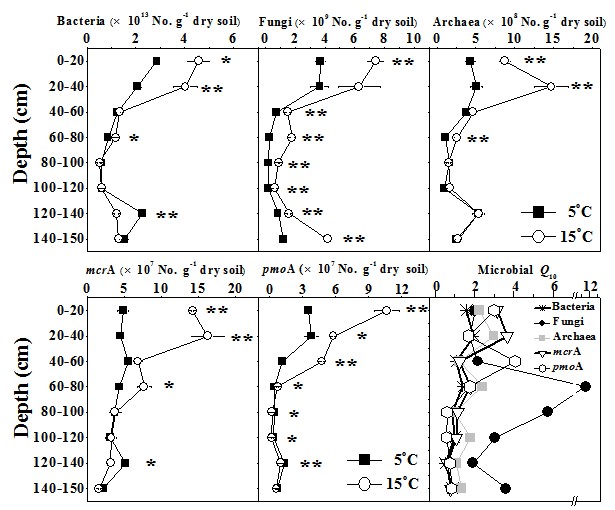Peatlands in permafrost region are large carbon pools sensitive to global warming. However, the effects of increased temperature on carbon emissions and associated microbial mechanism of permafrost peatlands remain largely unknown, especially when considering permafrost depths.
The researchers from the Northeast Institute of Geography and Agroecology of Chinese Academy of Sciences collected soil from 0 to 150 cm depth of a permafrost peatland in the Great Hing'an Mountain and incubated at 5 and 15 °C for 55 days. They revealed that elevated temperature significantly enhanced CO2 and CH4 emission in permafrost peatland, and the warming simulated CO2 emission is linked to the abundances of bacterial, fungal, archaeal, methanogen, and methanotroph abundances. Mean temperature sensitivity (Q10) values of CO2 and CH4 were 2.39 and 55.49, respectively. Q10 values of bacteria, fungi, archaea, methanogen, and methanotroph abundances were 1.17, 3.85, 1.75, 1.68, and 1.66, respectively. Similar to the trend of CO2 emissions, high bacteria, fungi, archaea, methanogen, and methanotroph abundances were observed in 0–20 cm and 20–40 cm layers, and such abundances increased along with temperature increasing. Whereas the 40-60 cm and 60-80 cm soil had the highest CH4 emission rates, which was correlated with soil water content.
Results of this study clearly reveal that under global warming, the surface permafrost thaw and the increase in active and transition layers may induce peatlands in permafrost regions to release more CO2 and CH4, which may contribute to carbon-climate feedbacks of permafrost soils.



The research papers by JIANG Lei, SONG Yanyu and SUN Li et al. were published in the journal of Applied Soil Ecology.
SONG Yanyu
Northeast Institute of Geography and Agroecology, Chinese Academy of Sciences
http://english.iga.cas.cn/
E-mail: songyanyu@iga.ac.cn